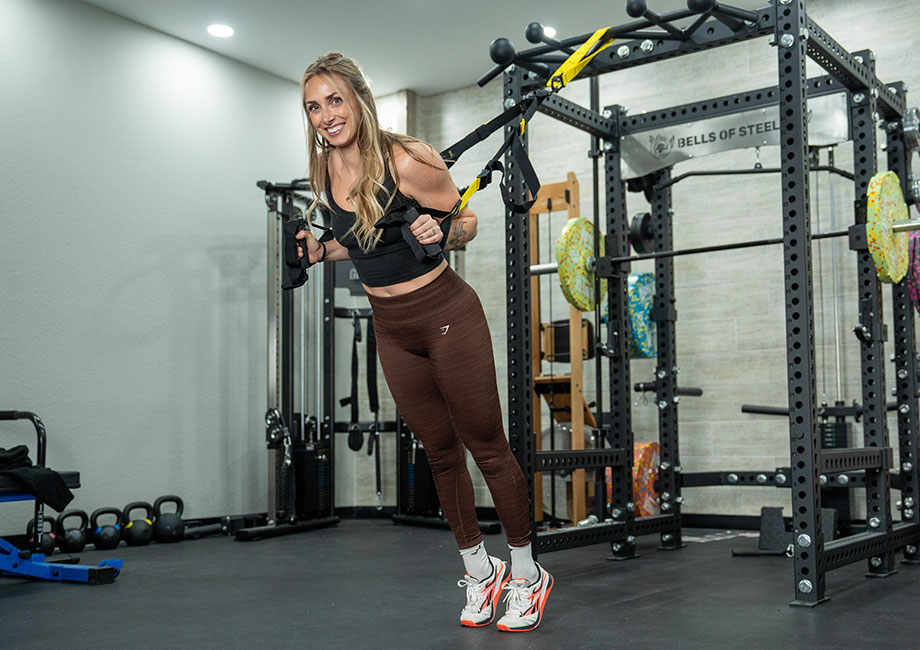We test and review fitness products based on an independent, multi-point methodology. If you use our links to purchase something, we may earn a commission. Read our disclosures.
Just because you aren’t training to be a Navy SEAL—i.e., the developers of the TRX suspension trainer—doesn’t mean you should miss out on the best TRX exercises. TRX suspension trainers allow you to perform resistance exercises without hauling around kettlebells or dumbbells, giving you one of the best portable home gym options. The beauty lies in the reliance on training with just your body weight, requiring little to no equipment while pursuing your fitness goals.
Believe it or not, I’ve coached my fair share of TRX classes and rely on their effectiveness with athletes and clients. And to be honest, when I hit the beach for vacation, I always bring a TRX training system and a pair of the best adjustable dumbbells with me. Follow along as I dish out the 10 best TRX exercises tailored for all fitness levels. Next, I’ll cover sample workouts designed to maximize your gains, and lastly, I’ll reveal the absolute best benefits that TRX exercises bring to the table.
10 Best TRX Exercises
- TRX Biceps Curl
- TRX Push-Up
- TRX Suspended Row
- TRX Fly
- TRX Squat
- TRX Triceps Extension
- TRX Hamstring Curl
- TRX Calf Raises
- TRX Pike
- TRX Pull-Up
RELATED: TRX Coupon Code
TRX Biceps Curl
Muscles worked: Biceps brachii, brachialis, brachioradialis, forearm muscles (flexors), core muscles (stabilizers), deltoids (shoulder stabilizers), upper-back muscles (scapular stabilizers)
Benefits: While still strengthening the biceps brachii, the TRX biceps curl adds a unique challenge by requiring stabilization of the body throughout the movement, engaging additional muscles for core stability and balance. Performing the curl with a palms-up grip1 (supinated) is potent for developing that “pop” in the biceps brachii to fill your sleeves.
How to do it:
- Adjust the TRX straps to mid-length.
- Stand facing the anchor point with your feet shoulder-width apart.
- Grasp the handles with an underhand grip, palms facing up.
- Lean back slightly, keeping your body in a straight line from head to heels.
- Pull your hands toward your shoulders and while keeping your elbows close to your sides.
- Pause at the top, then slowly extend your arms to return to the starting position.
- Repeat for the desired sets and reps.
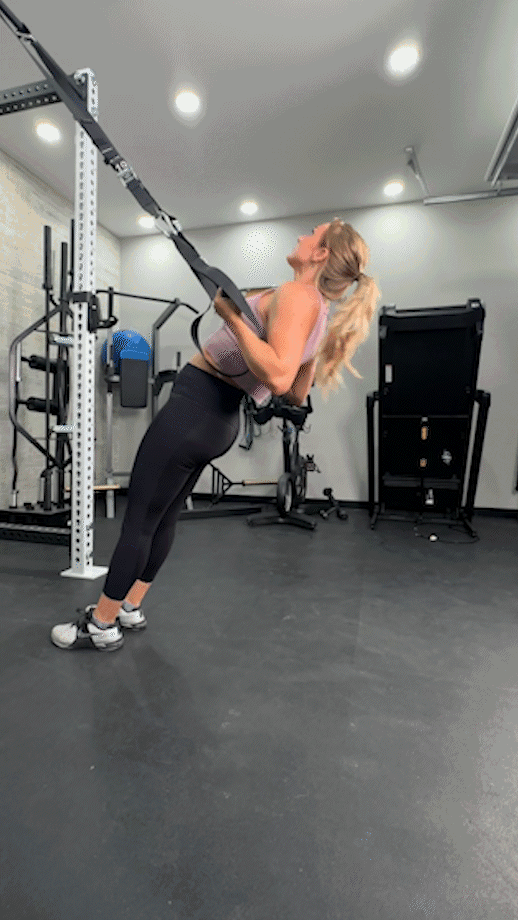
Modifications
- Dial it back: Adjusting the height of the straps will keep your body more upright, easing the difficulty of each curl.
- Make it harder: You can make these more difficult by lowering the height of the straps and positioning your body further from the anchor point. Another excellent option is to utilize tempos, pauses, and isometric holds.
RELATED: Tempo Training
TRX Push-Up
Muscles worked: Pectoralis major, anterior delts, triceps brachii , rectus abdominis, obliques, transverse abdominis, serratus anterior, rhomboids, trapezius, erector spinae
Benefits: TRX push-ups leverage suspension straps to introduce instability, uniquely challenging muscles in your chest, shoulders, triceps, and core. This instability forces greater muscle recruitment, enhancing overall strength and stability. You may notice heightened soreness as your muscles work harder to stabilize your joints. Moreover, TRX push-ups offer an increased range of motion through deficit training, allowing for greater muscle lengthening2 when lowering the chest sufficiently.
How to do it:
- Adjust the TRX straps to their full length.
- Stand facing away from the anchor point, gripping the handles with your palms down.
- Walk forward until your body forms an angle with the ground, resembling a push-up/plank position.
- Lower your chest toward the handles by bending your elbows.
- Push through your palms to return to the starting position.
- Repeat for the desired sets and reps.
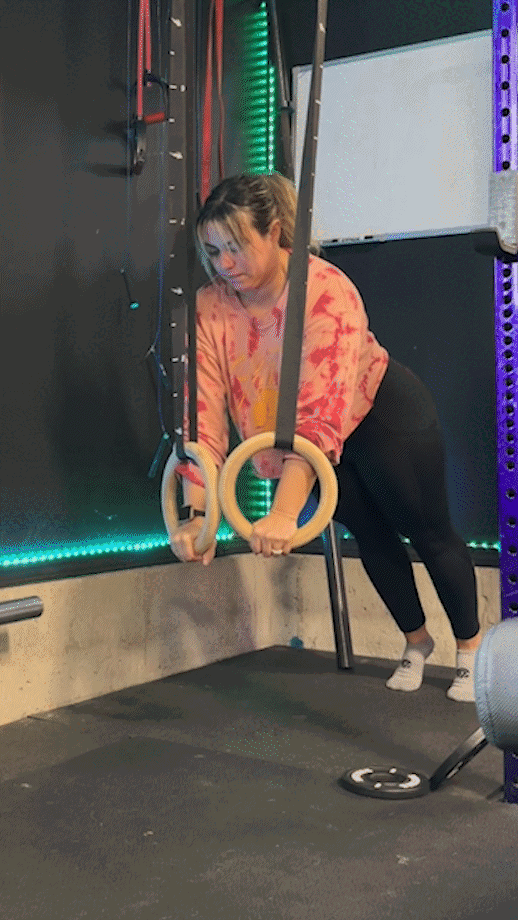
Modifications
- Dial it back: Adjusting the straps to a higher position can decrease the push-up angle, allowing this exercise to become a modified TRX chest press.
- Make it harder: Incorporating tempos, pauses, or a weighted vest will increase the intensity of the TRX push-up.
Expert tip: “Push” the handles to the floor when driving out of the bottom of the push-up. This will help stabilize the TRX handles and your body. Keep your core tight!
RELATED: 17 Push-Up Variations
TRX Suspended Row
Muscles worked: Latissimus dorsi, rhomboids, traps, rear delts, biceps brachii, forearms, core
Benefits: The TRX suspended row stabilizes and engages your upper back muscles, including your rhomboids, trapezius, latissimus dorsi, and biceps, due to the instability induced by the suspension straps. It’s particularly beneficial for individuals progressing toward pull-ups or chin-ups because it offers a bodyweight upper-body pulling exercise that simultaneously emphasizes core stability, bridging the gap for working towards upper-body strength goals.
How to do it:
- Adjust the TRX straps to mid-length and hang them above you.
- Stand facing the anchor point, gripping the handles with your palms facing each other.
- Lean back, keeping your body straight from head to heels.
- Pull your chest toward the handles by squeezing your shoulder blades together.
- Pause briefly at the top, then slowly lower yourself back down.
- Repeat for the desired sets and reps.
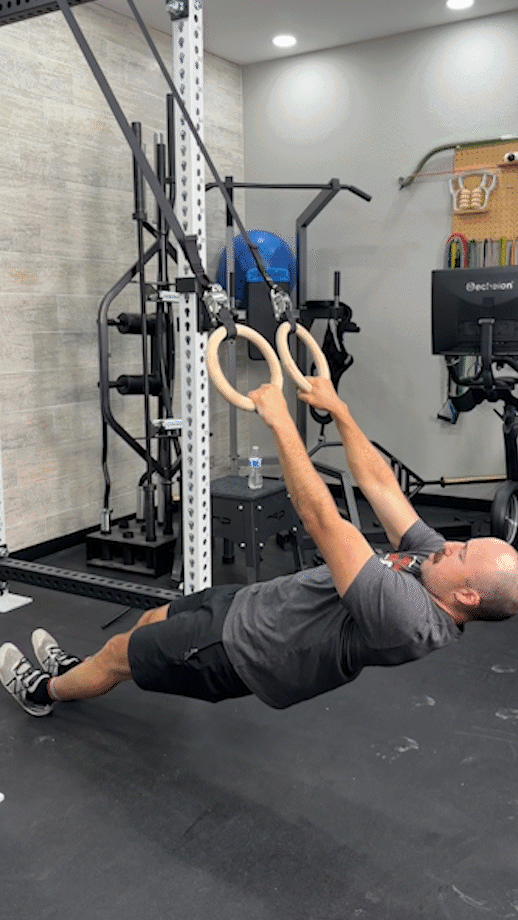
Modifications
- Dial it back: Maintain a more upright position during TRX rows by adjusting the handles to a higher position and stepping further away from the anchor point.
- Make it harder: To increase the intensity of your TRX rows, consider adding a weighted vest, incorporating controlled lowering phases, or adding a pause at the top of each repetition. Additionally, positioning your feet closer to the anchor point will make the row more challenging. Alternatively, a single-arm row variation increases difficulty and incorporates anti-rotation core training.
TRX Fly
Muscles worked: Pectoralis major, anterior delts, serratus anterior, triceps brachii, core
Benefits: Compared to traditional cable or dumbbell flyes, the TRX fly provides a free-standing option that demands greater engagement of the stabilizer muscles in your chest, shoulders, and core. Despite its distinct approach, the TRX fly isolates your pectoralis major and minor, with minimal assistance from your triceps and shoulders.
How to do it:
- Adjust the TRX straps to mid-length and hang them above you.
- Stand facing away from the anchor point, holding the handles with an overhand grip.
- Lean forward, keep your body straight, and slightly bend your arms in front of your chest.
- Lower your body by spreading your arms out to the side.
- Squeeze your pectoral muscles as you pull your hands back in front of your chest.
- Repeat for the desired sets and reps.
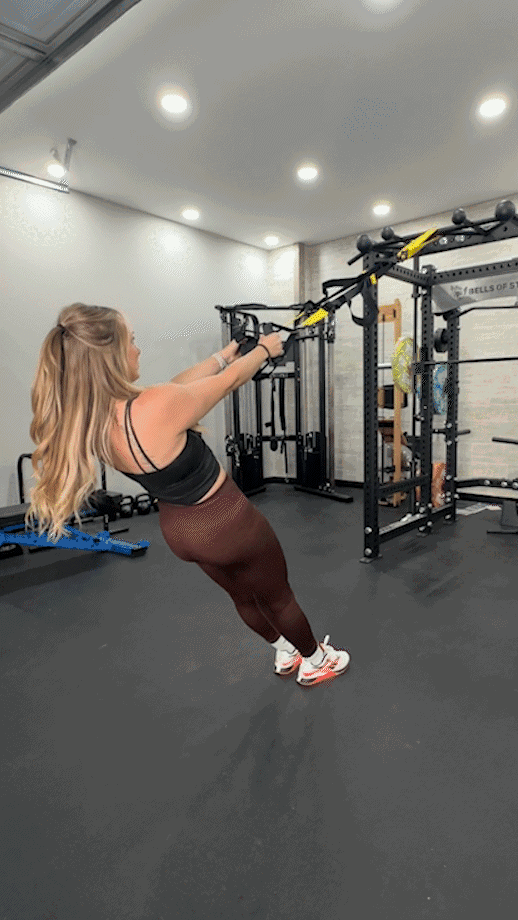
Modifications
- Dial it back: Adjust the straps to position your body more upright.
- Make it harder: Lower the straps, bringing your body closer to the floor, utilize tempos and pauses, or increase the range of motion by opening your arms wider.
TRX Squat
Muscles worked: Quad, gluteus maximus, hamstrings, adductors, gastrocnemius and soleus, erector spinae, core
Benefits: The TRX squat provides invaluable support and assistance, particularly beneficial for those learning proper squat form or recovering from an injury. The adjustable handles allow you to tailor the level of assistance to your needs, facilitating progression or regression as necessary. Seasoned lifters can further enhance the challenge by incorporating a weighted vest, intensifying resistance.
How to do it:
- Grab the TRX handles and stand facing the anchor point.
- Position your feet hip-width apart.
- Lean back, keeping your arms extended.
- Lower into a squat, bending your knees and hips.
- Maintain a lifted chest and straight back.
- Push through your feet to return to the starting position.
- Repeat for the desired sets and reps.
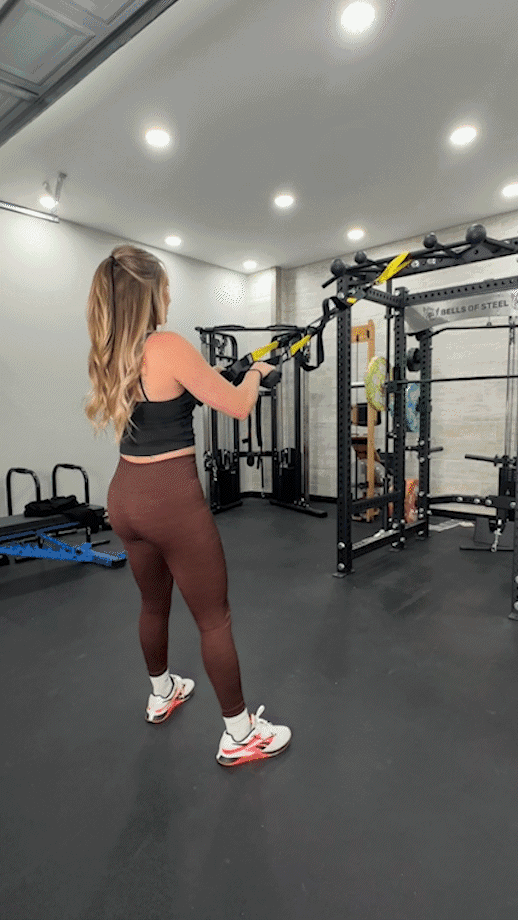
Modifications
- Dial it back: Rely on the straps more for assistance when standing up from the squat.
- Make it harder: Incorporate tempos, pauses, or add a weighted vest to increase the intensity of the TRX squat. Also, aim to use as little assistance as possible from the straps.
TRX Triceps Extension
Muscles worked: Triceps brachii, delts, serratus anterior, forearm muscles, core
Benefits: The TRX triceps extension offers a dynamic and functional approach to sculpting and strengthening the triceps muscles, distinct from traditional isolation exercises. By suspending your body weight against gravity, this exercise targets your triceps and engages a myriad of stabilizing muscles throughout your upper body and core to maintain balance and control. The continuous tension on the triceps throughout the movement uniquely stimulates muscle fibers for greater muscle growth and definition.
How to do it:
- Adjust the TRX straps to mid-length and hang them above you.
- Stand facing away from the anchor point, holding the handles with an overhand grip.
- Lean forward slightly and extend your arms in front of your body.
- Bend your elbows to lower your body toward the ground.
- Bring your hands to the top of your head, palms facing away.
- Pause, then push through your palms, as your triceps press the handles away from your body.
- Repeat for the desired sets and reps.
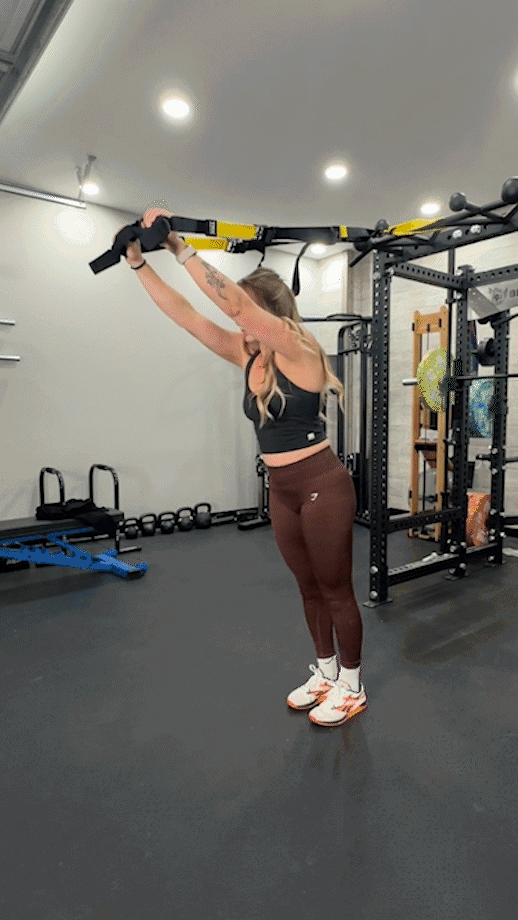
Modifications
- Dial it back: Adjust the straps to a higher position to maintain a more upright torso.
- Make it harder: Decrease the height of the straps to lower your body closer to the floor, increasing the recruitment of and providing a greater stretch in the triceps. Tempos and pauses will inherently increase your intensity from the standard start position.
TRX Hamstring Curl
Muscles worked: Hamstrings, gluteus maximus, erector spinae, core
Benefits: The TRX hamstring curl is impactful as it trains the hamstrings across the knee and hip joint3, an often overlooked attribute of lower body workouts. It’s a literal bridge as you establish the base position with a glute bridge, engaging your glutes and lower back. As a Certified Strength & Conditioning Coach (CSCS), what I appreciate most about the TRX hamstring curl is the fluid nature of the movement, as it encourages a seamless integration of concentric and eccentric muscle contractions.
How to do it:
- Set up the TRX straps to be fully lengthened and hang them above you.
- Lie on your back with your heels in the foot cradles, facing the anchor point.
- Lift your hips off the ground to form a straight line from head to heels.
- Bend your knees, and pull your heels toward your glutes, engaging your hamstrings.
- Extend your legs back out to the starting position.
- Repeat for the desired sets and reps.
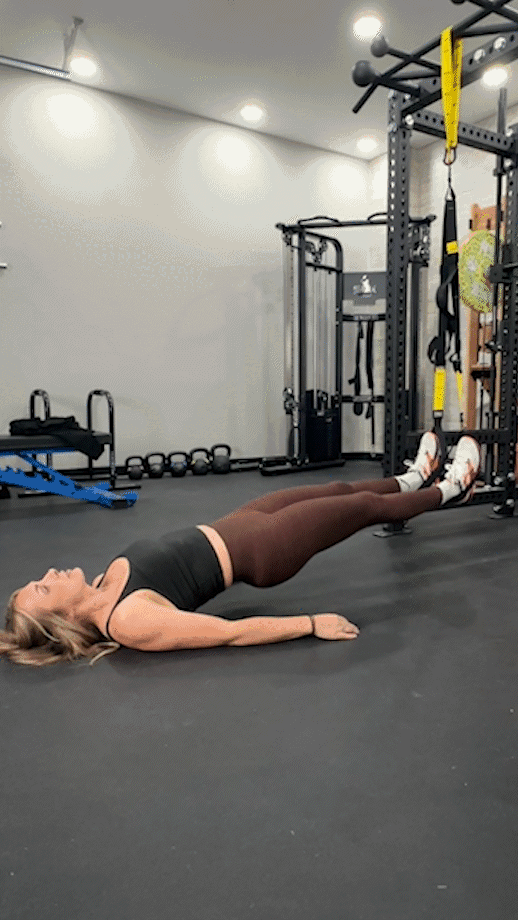
Modifications
- Dial it back: Allow your body to rest on the floor when returning to the start position.
- Make it harder: Single-leg TRX hamstring curls will intensify the effort for the working hamstring, glute, and hip. Another excellent option is to return to the start position with a slow movement, enhancing the eccentric contraction of the hamstrings.
Expert tip: Maintain a strong glute bridge position throughout the reps to increase posterior recruitment of your hamstrings, glutes, and lower back.
TRX Calf Raises
Muscles worked: Gastrocnemius, soleus, tibialis anterior
Benefits: The TRX calf raise offers a unique approach to calf muscle development by leveraging the suspension straps for upper-body support, enabling precise isolation of the calf muscles to stimulate hypertrophy and strength gains. This exercise targets your calf muscles effectively and enhances ankle stability and proprioception, which are crucial for athletic performance and injury prevention.
How to do it:
- Stand facing the anchor point with the TRX straps fully shortened.
- Hold the handles and lift yourself onto the balls of your feet.
- Lower your body back down, allowing your heels to drop, slowly.
- Repeat for the desired sets and reps.
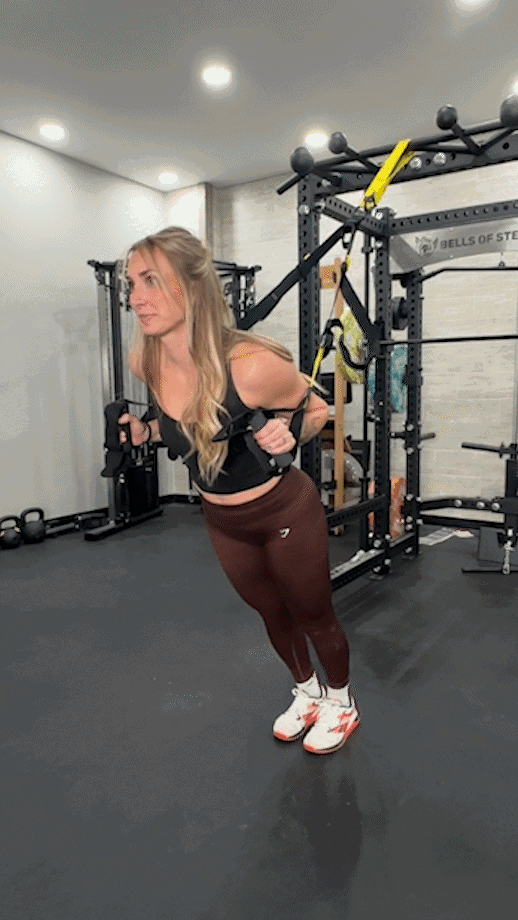
Modifications
- Dial it back: Rely on the handles for additional support as you press your feet down into the floor during the calf raise.
- Make it harder: Place the balls of your feet on an elevated surface, allowing your heels to go lower and intensify the stretch on your calves.
RELATED: Calf Exercises
TRX Pike
Muscles worked: Rectus abdominis, transverse abdominis, obliques, hip flexors, delts, rhomboids, traps, serratus anterior, erector spinae, glutes
Benefits: Performing just one repetition of this exercise ignites not only your core muscles but also engages your hip flexors, shoulders, upper back, and triceps. While it undoubtedly sculpts and strengthens the core, its benefits for upper-body strength and mobility should not be underestimated.
How to do it:
- Set up the TRX straps to be fully lengthened and hang them above you.
- Place your feet into the foot cradles and assume a push-up position with your hands directly beneath your shoulders.
- Engage your core and lift your hips towards the ceiling, forming an inverted “V” shape with your body.
- Hold for a moment at the top, then lower your hips back down to the starting position.
- Repeat for the desired sets and reps.
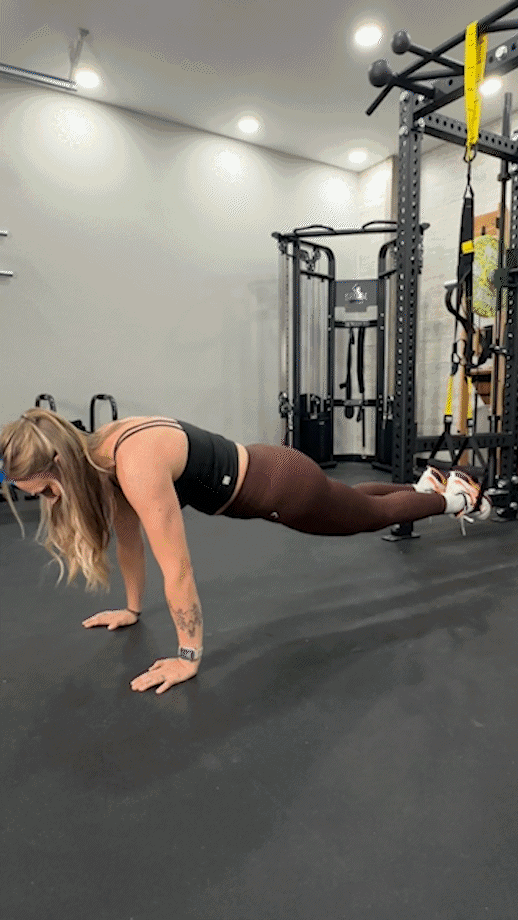
Modifications
- Dial it back: Shorten the strap length to help reduce your body’s angle. Alternatively, elevate your hands onto a bench or step to decrease the angle between your body and the ground. Lastly, focus on lifting your hips only partially, reducing the range of motion and making the movement more manageable.
- Make it harder: Focus on slower, controlled movements, increasing engagement. Lengthen the straps to intensify the exercise, requiring more strength to lift your hips. Aim for a higher hip lift to engage your core and shoulder muscles further
Expert Tip: Feel your feet pull towards your elbows as you contract your abs.
TRX Pull-Up
Muscles worked: Lats, biceps, chest, shoulders, forearms, erector spinae, core
Benefits: The TRX pull-up serves as a dynamic progression toward mastering traditional pull-ups. With the TRX, you can tailor the exercise intensity by adjusting handle height and controlling leg assistance, making it adaptable to your current strength level. This exercise targets the vertical muscle fibers of the lats while engaging various other muscle groups to bolster overall pull-up strength.
How to do it:
- Adjust the TRX straps to your shoulder height when standing.
- Grab the handles with an overhand grip.
- Position your body under the handles keeping a vertical torso, arms straight, and bending your knees to roughly 90-degrees.
- Pull yourself up toward the handles.
- Once your chest reaches the handles, slowly lower yourself back down to the starting position, maintaining control throughout the movement.
- Repeat for the desired number of repetitions.
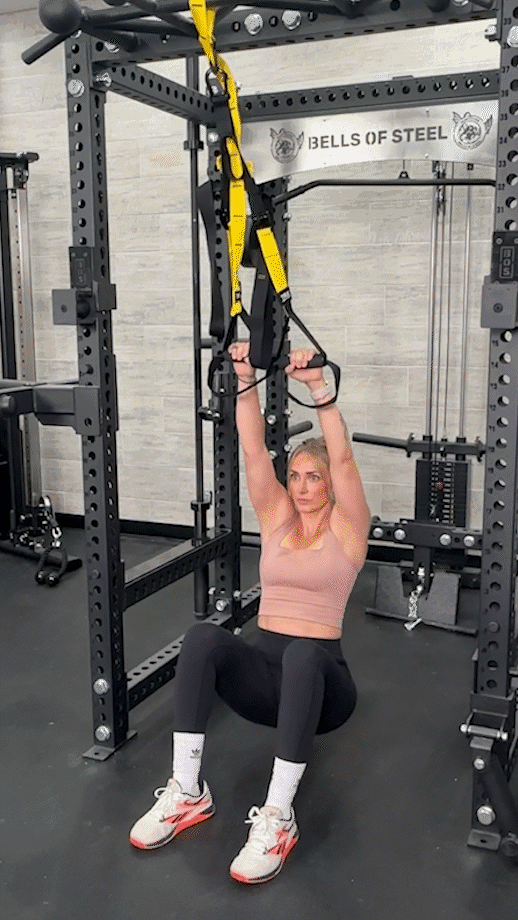
Modifications
- Dial it back: To modify the challenge of the TRX pull-up, adjust the handle height to shorten the range of motion. Alternatively, use your legs to provide additional assistance, enabling you to maintain proper form and gradually build strength.
- Make it harder: Incorporate tempos and pauses into your TRX pull-up routine for a quick adjustment. Alternatively, consider adding a weighted vest to ramp up the intensity and reduce your reliance on your legs for assistance.
Expert Tip: Pull the handles “down” to pull your body “up.” For beginners, use your legs for assistance as you move upward, but focus on longer lowering to enhance eccentric strength.
Sample TRX Exercise Workouts
Whether aiming to build strength, increase size, or start your fitness journey as a beginner, these sample workouts offer versatile routines to help you conquer your goals. You’ll get a taste of why TRX suspension training workouts are awesome for building full-body strength, size, and endurance.
Side note: Don’t forget to warm up! Here’s a quick one to get you ready to train:
- Side-lying t-spine rotation: 10 reps, each side
- Leg swing: 10 reps, each side
- Bodyweight squat: 10 reps
- Glute bridge: 10 reps
- Plank with shoulder tap: 10 reps, each side
RELATED: Best Warm-Up Exercises
TRX Workout for Strength
This TRX strength workout incorporates supersets to maximize efficiency and enhance the full-body training effect. Upper-body movements incorporate a deliberate three-second lowering phase to increase your strength and stability via eccentric training, complemented by lower-body exercises.
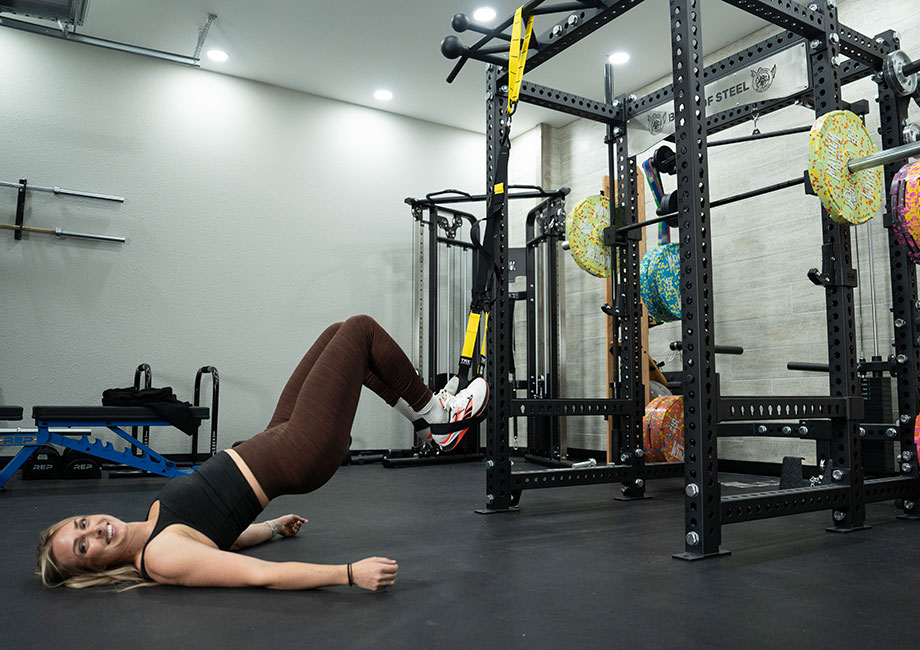
The session concludes with a challenging core exercise, the TRX pike. Keep your rest periods4 around two minutes after completing each round of the supersets.
| Exercise | Sets | Reps |
| A1. TRX Pull-Up | 4 | 6-10* |
| A2. TRX Hamstring Curl | 4 | 8-12 |
| B1. TRX Push-Up | 4 | 5-8* |
| B2. TRX Squat | 4 | 6-10 ea. |
| C1. TRX Pike | 3 | 5-10 |
Note: Perform a three-second lowering tempo.
Equipment needed: TRX suspension trainer, weighted vest (if desired)
TRX Workout for Size
Building upon the efficiency of supersets, this TRX hypertrophy session begins with a dynamic upper-lower body compound exercise combination, effectively engaging multiple muscle groups. As the workout progresses, the focus shifts to more isolated movements, culminating in a satisfying bodybuilding-style pump session to maximize muscle growth and definition.
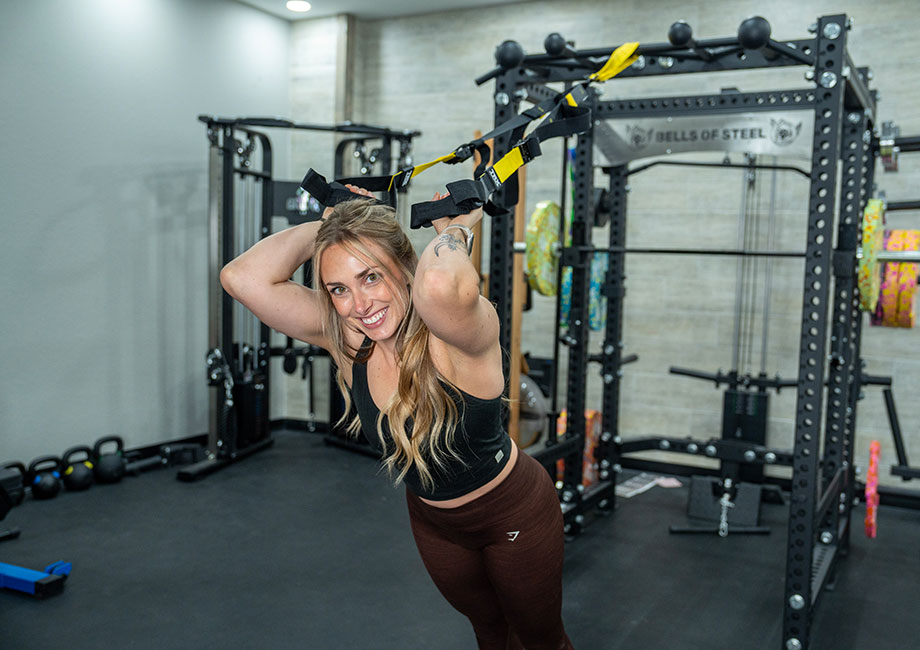
For hypertrophy workouts, you’ll want to keep the rest periods between 30 and 60 seconds between sets.
| Exercise | Sets | Reps |
| A1. TRX Suspended Row | 3 | 8-12 |
| A2. TRX Squat | 3 | 8-12 |
| B1. TRX Fly | 3 | 10-15 |
| B2. TRX Calf Raise | 3 | 10-15 |
| C1. TRX Triceps Extension | 3 | 12-15 |
| C2. TRX Biceps Curl | 3 | 12-15 |
Equipment needed: TRX suspension trainer, weighted vest (if desired)
TRX Workout for Beginners
This beginner TRX workout follows a circuit-style format, seamlessly blending strength, hypertrophy, and muscular endurance training. By incorporating multiple modalities in one session, beginners gain a comprehensive introduction to different training techniques while working through varying exercises.
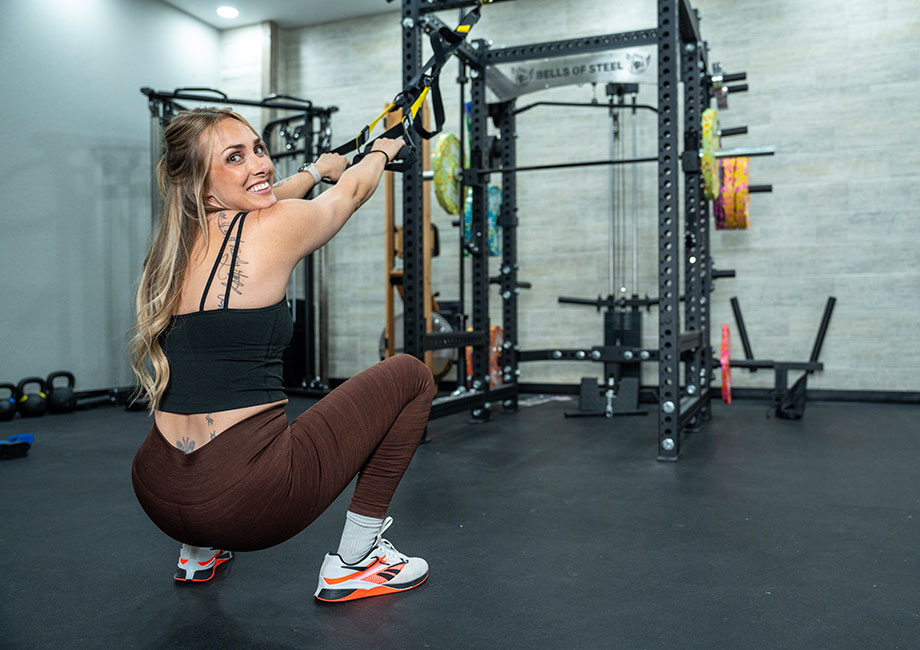
Simply complete three to four rounds of the exercises, moving from one to the next, with a rest period of two minutes between rounds.
| Exercise | Sets | Reps |
| TRX Squat | 2-3 | 8, each side |
| TRX Suspended Row | 2-3 | 8, each side |
| TRX Hamstring Curl | 2-3 | 8 |
| TRX Push-Up | 2-3 | 6 |
| TRX Plank* | 2-3 | 30 sec. hold |
Note: Set up like you would for the TRX pike, but hold the plank position instead.
Equipment needed: TRX suspension trainer, weighted vest (if desired)
Benefits of TRX Exercises
Next, let’s cover how TRX offers unparalleled workout options that adapt to your needs, enhance fitness qualities of strength, power, and stability, and harness the inherent benefits of bodyweight training for an unmatched fitness experience.
More Versatile Workout Options
Imagine having the ability to carry a fully-equipped gym in something as compact as a backpack, no matter where life takes you—that’s the beauty of TRX suspension training. With its portable suspension system, you can transform any space into your personal workout zone, ensuring that fitness remains within reach wherever you go.
TRX training offers versatile and convenient workout options by providing a portable and adaptable system that you can use virtually anywhere while also providing effective exercise variations, ensuring that workouts remain challenging and engaging, catering to diverse fitness levels and goals.
Helps Improve Strength, Power, and Core Stability
TRX workouts blend the fundamental components of an impactful workout regimen by integrating compound and isolation exercises with bilateral and unilateral movements to target multiple muscle groups while promoting strength, power, and core stability.
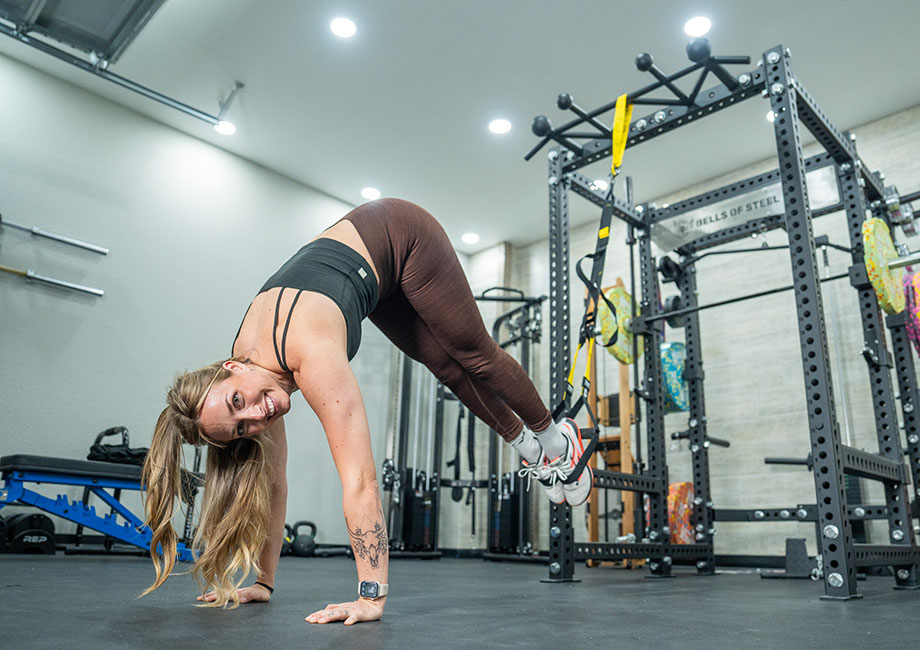
A December 2018 study in the Journal of Functional Morphology and Kinesiology5 confirmed that suspension training is beneficial for maintaining and improving acute strength and power performances, while a February 2017 study in the Journal of Human Kinetics6 revealed higher levels of activation in the core muscles when using suspension training exercises, boosting core strength levels.
Enhances Bodyweight Workouts
One notable benefit of TRX exercises is their reliance on bodyweight resistance to build strength, stability, and muscular endurance and size. In an October 2022 study in the Journal of Yoga and Physiotherapy7, researchers found that bodyweight training methods can significantly improve muscular strength and endurance.
Additionally, bodyweight workouts with TRX allow seamless modifications to accommodate various fitness levels, ensuring inclusivity and adaptability for individuals of all backgrounds and abilities.
TRX Exercises: Final Thoughts
The best TRX exercises offer versatility and diversity in your workouts while amplifying the benefits of bodyweight training.
- TRX training offers versatile and convenient workouts.
- They’re excellent for all fitness levels and training goals.
- The best TRX exercises integrate compound and isolated exercises with bilateral and unilateral movements.
- TRX workouts provide unparalleled stability for your muscles and joints, promoting strength, power, and stability throughout your entire body.
- These exercises utilize bodyweight training and can be enhanced by incorporating tempos, pauses, or tossing on a weighted vest.
TRX Exercises: FAQs
Is TRX a good workout?
The TRX suspension trainer delivers potent workouts that utilize your body weight for resistance. You can easily ramp up the intensity of the best TRX exercises by integrating tempos and pauses or strapping up with one of the best weighted vests.
As a strength coach, what I particularly admire about these workouts is their versatility; you can crush a full-body routine that trains through multiple planes of movement with a piece of equipment that you can take anywhere.
Is TRX good for losing weight?
When it comes to losing body fat, working out with the TRX suspension system is only one piece of the puzzle. Dialing in your fitness regimen to complement your weight loss goals will get you started in the right direction.
Here are a few fitness tips to help elevate your weight loss gains:
-Pair strength training with cardio.
-Perform full-body workouts.
-Use shorter rest periods.
-Mix up your routine: HIIT, hypertrophy, strength, and cardio are all great options.
-Aim to train three to five times per week. Consistency is key!
Beyond working out, you’ll need to ensure nutrition, hydration, and recovery (sleep!) are in check.
RELATED: Full-Body Workout At Home
How many times a week should you do TRX?
other factors like recovery time and overall workout schedule. However, a general recommendation is to aim for two to three sessions per week, ensuring at least one day of rest between sessions. This rest day is crucial for adequate recovery, allowing your body to adapt and grow stronger. If you train less throughout the week, aim for full-body sessions. Otherwise, utilize one of the top workout splits to solidify your training.
How long does it take to see results from TRX?
Unfortunately, there’s no concrete answer for how long it’ll take to see results from fitness-related efforts. However, you’ll increase your chances if you’re consistent, bring effort to your workouts, and check all the boxes for items “outside the gym.” I’m talking about rest, recovery, nutrition, and hydration. Results come at a different pace for everyone. Keep crushing your workouts, fine-tune your diet, and the results will come soon.
References
- Coratella, Giuseppe et al. “Biceps Brachii and Brachioradialis Excitation in Biceps Curl Exercise: Different Handgrips, Different Synergy.” Sports (Basel, Switzerland) vol. 11,3 64. 9 Mar. 2023, doi:10.3390/sports11030064
- Wolf, M., P. Androulakis-Korakakis, J. Fisher, B. Schoenfeld, and J. Steele. “Partial Vs Full Range of Motion Resistance Training: A Systematic Review and Meta-Analysis”. International Journal of Strength and Conditioning, Vol. 3, no. 1, Mar. 2023, doi:10.47206/ijsc.v3i1.182.
- Bankoff, A D P et al. “Electromyography study of the hamstring muscles while exercising on a bicycle and the Roman table.” Electromyography and clinical neurophysiology vol. 44,5 (2004): 293-300.
- Willardson, Jeffrey M PhD, CSCS. “A Brief Review: How Much Rest between Sets?.” Strength and Conditioning Journal, vol. 30, no. 3, June 2008, pp. 44-50. DOI: 10.1519/SSC.0b013e31817711a4
- Giancotti, Giuseppe Francesco et al. “Short-Term Effects of Suspension Training on Strength and Power Performances.” Journal of functional morphology and kinesiology vol. 3,4 51. 23 Oct. 2018, doi:10.3390/jfmk3040051
- Cugliari, Giovanni, and Gennaro Boccia. “Core Muscle Activation in Suspension Training Exercises.” Journal of human kinetics vol. 56 61-71. 15 Mar. 2017, doi:10.1515/hukin-2017-0023
- Del Vecchio, Luke, et al. “Bodyweight Training for Muscular Strength & Endurance.” Journal of Yoga & Physiotherapy, vol. 10, 2022, pp. 001-005. DOI: 10.19080/JYP.2022.10.555783.
Further reading

Our Surplus Strength Pulley review will let you know if this is the best choice for a cable pulley system. Read more

Have you been watching the roller skating videos on TikTok and want to learn how to roller skate? A CPT walks (or rolls) you through what you need to know. Read more

The upright row is just what you need for bigger shoulders and a strong upper back. Check out our guide to find out more about this awesome exercise! Read more

Joe Rogan, the stand-up comedian, and Host of The Joe Rogan Experience Podcast has one EPIC gym. Located in his podcast studio, Joe has utilized the top equipment manufacturers and technology to create a world-class facility. Today, we’re going to detail the tools Joe used to build his studio gym along with the training plan, nutrition, and supplements he uses to build his body and mind. Read more

